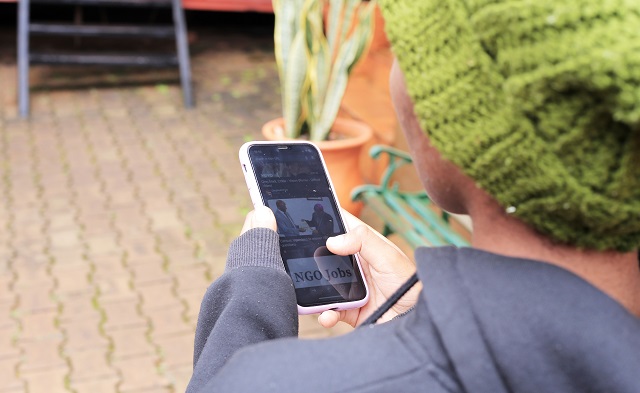
There was no cross-associations between well-being and their social media usage among boys
Kampala, Uganda | RONALD MUSOKE | Girls who use social media for an hour or more on a school day have been found to have lower levels of well-being than those who use less, according to the latest Global Education Monitoring (GEM) report by UNESCO.
The report shows girls are at risk of decreased self-esteem, anxiety, and depression. They are exposed to content promoting gendered professions, unrealistic body standards, sexually explicit images, cyberbullying all of which place added strain on their mental health and well-being and academic achievement.
Girls were found to be twice as likely as boys to suffer an eating disorder which is exacerbated by the use of social media. Facebook’s own research has found that 32% of teenage girls said when they felt bad about their bodies, Instagram made them feel worse. Tik Tok’s algorithms have also been found to target teenagers with body image and mental health content every 39 seconds and with content related to eating disorders every 8 minutes.
The gender edition of the 2023 GEM Report was released on April 25 to coincide with the ‘International Girls in ICT Day’ at an event organised by the AU International Centre for Girls and Women’s Education in Africa (AU/CIEFFA).
The report titled, “Technology on Her Terms” warns that increasing exposure to algorithm-driven, image-based content is exposing girls to inappropriate material, ranging from sexual harassment, to videos that glorify unhealthy behaviours or unrealistic body standards.
According to the report, there was no cross-associations between well-being and their social media usage among boys.
Overall, the report tells positive stories of girls’ education access, attainment and achievement, which is helping reverse decades of gender-based discrimination. It mentions how radio, television and mobile phones have provided a learning lifeline for millions of girls, particularly those in crisis contexts.
However, the report notes that while technology offers many girls opportunities to access important education content in safe environments, for instance, on comprehensive sexuality education; technology in practice often exacerbates negative gender norms and stereotypes.
Anna Cristina d’Addio, the thematic lead for the GEM Report says while digital technology offers new opportunities for teaching and learning, it also comes with risks.
The internet including its use as part of education exposes users to misuse of their personal data, invasion of privacy, abuse, theft of identity, offensive messages and images, cyberbullying, scams, fake news and misinformation.
Image abuse is common
According to the report, digital environments become arenas for gender-based violence and school-related gender-based violence is a significant global issue. There are many forms of sexual violence such as online solicitation, coercive sexting, and cyber-dating violence often made without immediate consequences. For example, nine in 10 girls surveyed in the United Kingdom schools and colleges, said that they had been sent pictures or videos they did not want to see.
The report notes that the danger of deep fakes made by artificial intelligence is also spilling over into school environments. In Brazil and Spain, school girls have been victims of deep fake pornographic images circulating in schools, while female teachers have been recorded as victims of the abuse in the United States.
Audrey Azoulay, the Director-General of UNESCO says “technology is not yet gender neutral.” Azoulay says the persistent lack of women representation in technology design and deployment is partly to blame for the predicament. According to the report, in 2022, women held less than 25% of science, engineering and information and communication technology jobs.
This has had real consequences on algorithms and data sources, which perpetuate and amplify gender biases. According to a recent UNESCO study of generative AI models, a woman is described as a “model” or a “waitress” in 30% of automatically generated texts, while male names are associated with terms such as “business” and “career.”
Pernicious and powerful prejudices among content generators and negative stereotypes paint science, technology, engineering and mathematics as male-oriented fields, causing girls and young women to veer away from STEM (Science, Technology, Engineering and Mathematics) career tracks – despite their very real capabilities in these domains.
All these factors have created a feedback loop: where girls are exposed to negative gender norms, steered away from studying STEM subjects, and got deprived of the opportunity to shape the very tools that expose them to these stereotypes.
Uganda affected too
According to a Uganda Communications Commission (UCC) report titled, “Ugandan Children’s Online Survey 2020,” up to 8 in every 10 children interviewed had some level of digital literacy or knew how to use the internet, social media, and apps on devices.
Of these, 68% lived in urban areas and 22% in rural areas. Nine out of every 10 children had used the internet in the previous year compared to only 3 in 10 of parents or guardians. When asked whether they knew what their children could use or were using the internet for, only three in 10 of the parents were certain they knew.
According to the report, 9 out of 10 children interviewed said they used a smart phone or a feature phone to access the internet and this was being done from home and particularly in their beds. Only 3 out of 10 children reported accessing and using the internet at school. The reason most children were using the internet at home was due to paid internet by their parents.
Majority reported being constrained by infrastructure and rules that prohibit the use of internet enabled devices such as phones while at school. Still, many said they were using these devices in school secretly.
Online risks
According to the UCC report, there were disturbing trends around the risks or threats online. For instance, less than half of children who use the internet (44.6%) said they knew how to act in different situations online.
Despite this risk, nine in 10 children said they never contacted their parents about issues they encountered online. Most children said they had not personally been bothered by anything online but for those that had faced some issues, they said they were upset by the occurrence of these issues but they either did nothing or “sorted out” the issue by themselves.
Seven out of 10 children interviewed claimed to have friends whom they can rely on to help them or count on when things go wrong, and nearly four out of five kids (77%) believe that their friends have genuinely attempted to help them.
In addition, at least 5 in every 10 of one’s friends were more inclined to encourage them to explore and learn things on the internet. This, the report notes, is a clear indication that there are unsettling patterns regarding the threats online.
Unwanted sex experiences
According to the report, one in every five children online had seen a sexual image online in the past 12 months prior to the survey, and in terms of gender, slightly more boys (28.1%) than girls (22.6%) had seen a sexual image.
More children (4 in 10 children) in urban areas were exposed to sexual images, especially those above the age of 11. Social networking sites were the most common platforms where children claimed to have seen these sexual photos, and nearly half of them (44.7%) were accessed through a mobile device with internet access. And one in every 10 children admitted to having gone ahead to share a sexual image.
Rose Kyarimpa, a counselor and director of Buhumuriro Counselling Centre in the western city of Mbarara says she counsels many upper secondary and university going female students. She says many of the girls are affected by the negative social media content but also the feedback they get when they post their photos on their social media pages.
“For some of them, a lot of the content they see is a trigger to their unhealed trauma; they look at this content and it reminds them of things they experienced when they were younger.”
“They have reported how some social media users have pointed how they don’t have ‘nyash’ (ample bottoms).” Kyarimpa recommended raising awareness and building self-esteem of teenage girls to cope with cyber bullying.
According to the GEM report, the need to protect children and youth against online digital risks is gaining momentum worldwide with development of legal frameworks and educational programmes.
For instance, Portugal has comprehensive guidelines on teaching about gender and internet safety, the U.S. has a Kids Online Safety Act, and Italy has a 2017 law stipulating protection and education for children both as victims and perpetrators, and Slovenia has projects to raise awareness about online dating violence.
About 1 in 4 countries have banned mobile phones in school with laws or policies. Some countries have banned phones for younger students (Finland and France) and others for their older peers (Netherlands). Some have blocked access to specific social media or software in schools.
In Uganda, Filbert Baguma, the General Secretary of the Uganda National Teachers Union (UNATU) says digital gadgets are at the centre of the new lower secondary school curriculum which encourages learners to do research and be innovative in their thinking to originate new ideas.
“But, as they look for educational content, the learners get exposed to other undesirable content and this is where the challenge lies,” he told The Independent.
He says some schools have policies banning smartphone use. Therefore, the government needs to come up with a policy on deployment and usage of digital tools and platforms in the school environment.
“The learners are exposed to them and even when there is a ban on these gadgets, we see learners smuggling these gadgets into schools and using them at awkward times. What we now need to do is regulate their use.”
Baguma told The Independent on May 03 that when learners eventually go home and get free access to these gadgets at home “they are like chickens on free-range; they do whatever they want.”
Parental guidance
According to UCC, parents and guardians should consider picking interest and keeping an eye on what their children are doing online, including, but not limited to, the websites they visit, the social media platforms they use, and, whenever feasible, who they are interacting with and whether they know them in real life.
“While using the internet at home, keep kids in view, monitor your child’s online conversations, for instance, by frequently looking at their browser history; be on the lookout for possible indicators of child online abuse, such as attempts to hide online activity, changes in how internet-enabled devices are used, withdrawn behaviour, irrational outbursts, anxiety, and sadness.”
The UCC also advises Ugandan parents to consider installing parental restrictions on the kids’ internet-accessing gadgets, particularly portable ones; encourage children to report requests for sexual activity or other improper behaviour to a parent, guardian, or other trusted adult.
“Any suspicion of child sexual exploitation or online enticement can be reported toll-free 24/7,” the UCC report says. In addition, the report adds, the Uganda government should come up with a deliberate policy on teaching digital skills, especially online safety, starting in primary school.
For Azoulay, the UNESCO Director-General, ensuring that technological applications are no longer predominantly designed by men will go a long way in improving the situation for girls.
“Ultimately, the main lesson of our report is this: technological progress may support educational and social progress – but only if we are the masters of technological tools, rather than their servants. “Only if we leverage technology in education, on our terms,” she says.
 The Independent Uganda: You get the Truth we Pay the Price
The Independent Uganda: You get the Truth we Pay the Price


